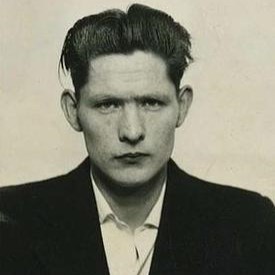
d: 1962
James Smith
Summary
Name:
James SmithYears Active:
1962Status:
ExecutedClass:
MurdererVictims:
1Method:
BludgeoningDeath:
November 29, 1962Nationality:
United Kingdom
d: 1962
James Smith
Summary: Murderer
Name:
James SmithStatus:
ExecutedVictims:
1Method:
BludgeoningNationality:
United KingdomDeath:
November 29, 1962Years Active:
1962Date Convicted:
October 17, 1962bio
James Smith was born in 1936 in Edinburgh, Scotland. He grew up in modest circumstances and eventually settled in Manchester, England, where he lived with his wife and two young children. At the time of the crime, Smith worked as a rubber moulder in Failsworth, earning around £15 per week, a typical wage for industrial laborers in the early 1960s. Despite being a father of two, Smith had already acquired a criminal record, with his fingerprints kept on police file due to earlier offences.
murder story
On Friday, 4 May 1962, James Smith entered the sweetshop owned by 58-year-old Sarah Isabella Cross, located at the corner of Hulme Hall Lane and Iron Street in Miles Platting, Manchester. His motive was robbery. Once inside, he launched a brutal assault on Cross, using bottles of orangeade and cherryade manufactured by Wild Bros of Heywood as weapons. A total of five bottles were smashed over her head, each shattering under the force of the blows. Cross was left dead behind the counter, beaten to death for the sake of just £6 stolen from the till.
Smith fled the shop through a rear exit, leaving coins scattered on the floor in his panic. The murder was quickly discovered, and investigators soon pieced together a strong case against him. Forensic experts found a clear fingerprint belonging to Smith on a door frame that had only been painted two days earlier by Cross’s husband. Since the paint was still tacky, the print was distinct.
Further evidence mounted when the broken bottles from the crime scene were meticulously reassembled at the North West Forensic Science Laboratory in Preston. Smith’s home was searched, and investigators used a modified vacuum cleaner to recover microscopic glass fragments from his clothing and his sofa. These tiny shards matched the reassembled bottles exactly, firmly tying him to the crime scene.
Smith was arrested at his home on Corfe Street, Beswick, by Detective Chief Superintendent Eric Cunningham and Detective Inspector Tommy Butcher. With physical evidence stacked against him, including blood traces and the forensic glass match, prosecutors moved swiftly to bring him to trial.
On 15 October 1962, Smith went before Mr Justice Stable and a jury in Manchester. The trial lasted only three days. The jury deliberated for just 20 minutes before finding him guilty of murder. Under the Homicide Act 1957, any killing committed in the course of theft or robbery was automatically deemed a capital offence. This meant Smith received a mandatory death sentence.
On Wednesday, 28 November 1962, James Smith was executed by hanging at Strangeways Prison in Manchester. The executioners were Harry Allen, one of Britain’s last official hangmen, and his assistant John Underhill. Smith’s execution made him the sixth-to-last person executed in a British prison, just three years before the death penalty was abolished for murder in the United Kingdom.
After his death, Smith’s body was buried in an unmarked grave within the prison grounds, as was customary at the time. In the early 1990s, when Strangeways prison underwent major changes, the remains of executed prisoners were exhumed, cremated, and interred at Blackley Cemetery, Manchester, in plots C2710 and C2711.